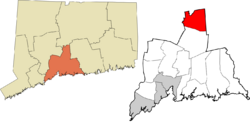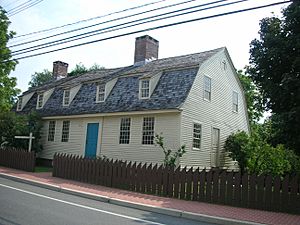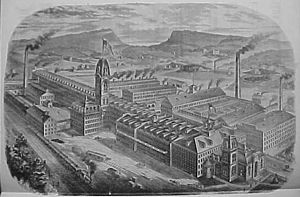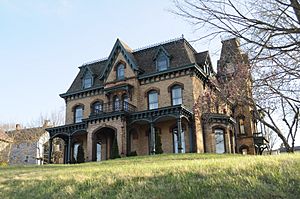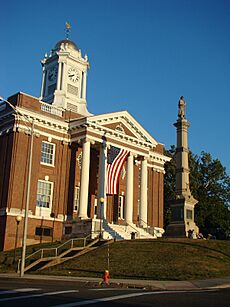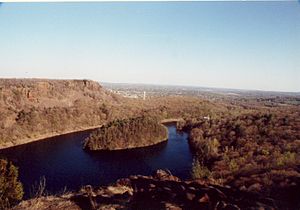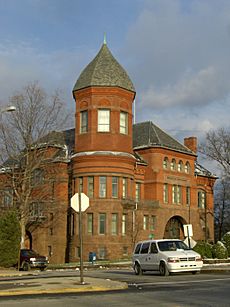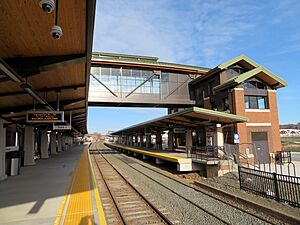Meriden, Connecticut facts for kids
Quick facts for kids
Meriden, Connecticut
|
||
|---|---|---|
|
City
|
||
| City of Meriden | ||
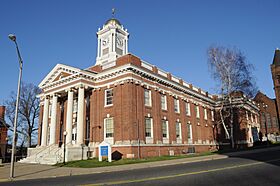
City Hall, Meriden
|
||
|
||
| Nickname(s):
The Silver City
|
||
 New Haven County and Connecticut New Haven County and Connecticut |
||
| Country | United States | |
| U.S. state | ||
| County | New Haven | |
| Region | South Central CT | |
| Incorporated (town) | 1806 | |
| Incorporated (city) | 1867 | |
| Consolidated | 1922 | |
| Government | ||
| • Type | Council-manager | |
| Area | ||
| • Total | 24.16 sq mi (62.58 km2) | |
| • Land | 23.80 sq mi (61.64 km2) | |
| • Water | 0.36 sq mi (0.94 km2) | |
| Elevation | 177 ft (54 m) | |
| Population
(2020)
|
||
| • Total | 60,850 | |
| • Density | 2,557/sq mi (987.2/km2) | |
| Time zone | UTC– 05:00 (Eastern) | |
| • Summer (DST) | UTC– 04:00 (Eastern) | |
| ZIP Codes |
06450–06451
|
|
| Area code(s) | 203/475 | |
| FIPS code | 09-46450 | |
| GNIS feature ID | 0208834 | |
| Airport | Meriden Markham Airport | |
| Major highways | ||
| Commuter rail | ||
Meriden is a city in New Haven County, Connecticut, United States. It's located right in the middle of two bigger cities: New Haven and Hartford. Meriden is part of the South Central Connecticut Planning Region. In 2020, about 60,850 people lived in the city.
Contents
- History of Meriden
- Geography of Meriden
- People of Meriden
- Fun Things to See and Do
- Education in Meriden
- News and Media
- Transportation in Meriden
- Famous People from Meriden
- Images for kids
- See also
History of Meriden
How Meriden Began
Meriden was first a part of the nearby town of Wallingford. In 1727, it got its own meetinghouse. It became a separate town in 1806, with over 1,000 people living there. Meriden became a city in 1867, with almost 9,000 residents. At one point, people even thought about making it the capital of Connecticut! The city was named after a village in England called Meriden, West Midlands.
The oldest house still standing in Meriden is the Solomon Goffe House. It was built in 1711 and became a museum in 1986. You can also find the grave of Timothy Jerome, who was a great-great-great grandfather of Winston Churchill, in a place now called "Burying Ground 1720."
Meriden's Manufacturing Boom (1800s to WWII)
In the second half of the 1800s, Meriden became a very important place for manufacturing. Many companies started or moved to the city. They mainly made silver, lamps, metalware, glass, guns, and musical instruments. Many new designs and technologies were invented here.
The "Silver City"
Meriden earned the nickname "Silver City" because of its many silver manufacturers. Companies like the Meriden Britannia Company were very famous. This company later became part of the International Silver Company. The International Silver Co. kept making silver until the early 1980s. Other companies also made cutlery, like the Meriden Cutlery Co.
In 1876, the Meriden Britannia Company won a top award for its plated silver at a big exhibition in Philadelphia. This helped them become known as the largest silverware company in the world by the end of the 1870s.
Lamps and Metalware Makers
Companies like the Edward Miller & Co and the Bradley & Hubbard Manufacturing Company made lamps and metalware. These companies were known all over the country and even internationally. Bradley & Hubbard also made decorative tables and fireplace tools.
Glassware and Appliances
Other companies made beautiful glassware, like the C.F. Monroe Company. Manning, Bowman & Co. made kitchen appliances and chrome items. Meriden was also home to gun makers like Parker Brothers (guns). The Meriden Firearms Co. made small guns from 1905 to 1918.
Musical Instruments and Player Pianos
Companies like Wilcox and White and the Aeolian Company made musical instruments, including player pianos. The Aeolian Company grew so much that it even opened a music hall in New York City.
Innovations in Graphic Arts
Meriden was also important for new ideas in printing. The Meriden Gravure Company started in 1888. They became experts in making high-quality copies of images, which was very useful for the silver industry.
Because of all this success, many beautiful mansions were built in Meriden, especially on Broad Street.
An important historical event happened on March 7, 1860. Abraham Lincoln visited Meriden to give a speech. He was hoping to become the Republican presidential candidate.
Many public places were also built during this time. Hubbard Park was paid for by Walter Hubbard, who owned the Bradley & Hubbard company. In 1900, Castle Craig was built on a peak in the park. In 1903, the Curtis Memorial Library opened across from Meriden's city hall.
Meriden's Hollywood Connection
From 1937 to 1947, the International Silver Company sponsored a national radio show called the Silver Theater. It featured many famous Hollywood actors like Jimmy Stewart and Rosalind Russell. Later, in 1949–1950, The Silver Theatre became a TV show on CBS, also sponsored by the International Silver Company.
Meriden's Design Legacy
Thousands of designs from Meriden's manufacturing past are now in museums around the world. These designs have been shown in over 200 exhibitions since the 1850s. For example, a tea urn designed by Eliel Saarinen for the International Silver Company is famous as a modern design icon.
Meriden designs are still featured in museum shows today. In 2017, Meriden designs were shown in museums in Dallas, New York, and even in Europe. Some special items from Meriden have become very valuable to collectors. For instance, a rare lamp sold for $85,000, and a coffee set sold for $377,000!
From WWII to the 1970s
During World War II, Meriden's factories worked non-stop, 24 hours a day. In 1944, Meriden was even named a "National Ideal War Community." Famous entertainers like Jimmy Durante and Glenn Miller came to celebrate.
After the war, Meriden continued to be a center for design. In 1947, Meriden became known for modern art with an exhibition called Painting toward architecture. This show traveled across the United States and was very important for bringing European art ideas to America.
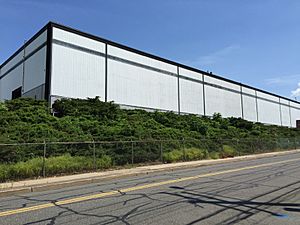
In 1965, a new part of the Miller Company building was finished. Its black-and-white modern look was designed by the famous American architect Philip Johnson.
In 1976, Jimmy Carter visited Meriden City Hall during his campaign for President.
Meriden from the 1980s to Today
Today, Meriden is home to the main house of the Franciscan Sisters of the Eucharist and the Franciscan Brothers of the Eucharist. The headquarters of Eastern Mountain Sports is also located here.
Geography of Meriden
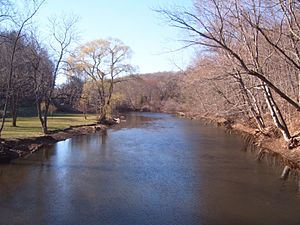
Meriden covers about 24.1 square miles (62.5 square kilometers). Most of this area is land, with a small part being water.
Meriden is known for its beautiful mountains, which are part of the Metacomet Ridge. These include the Hanging Hills (with peaks like West Peak and East Peak), Lamentation Mountain, and Chauncey Peak. Castle Craig, a famous city landmark, was built in the Hanging Hills within Hubbard Park.
The Quinnipiac River flows through the southwest part of the city, known as "South Meriden." Here, it goes through a gorge with cool sandstone and brownstone cliffs.
Main Areas in Meriden
- Meriden Center
- South Meriden
People of Meriden
| Historical population | |||
|---|---|---|---|
| Census | Pop. | %± | |
| 1820 | 1,309 | — | |
| 1870 | 8,893 | — | |
| 1880 | 15,540 | 74.7% | |
| 1890 | 21,652 | 39.3% | |
| 1900 | 24,296 | 12.2% | |
| 1910 | 27,265 | 12.2% | |
| 1920 | 29,867 | 9.5% | |
| 1930 | 38,481 | 28.8% | |
| 1940 | 39,494 | 2.6% | |
| 1950 | 44,088 | 11.6% | |
| 1960 | 51,850 | 17.6% | |
| 1970 | 55,959 | 7.9% | |
| 1980 | 57,118 | 2.1% | |
| 1990 | 59,479 | 4.1% | |
| 2000 | 58,244 | −2.1% | |
| 2010 | 60,868 | 4.5% | |
| 2020 | 60,850 | 0.0% | |
| U.S. Decennial Census | |||
In 2010, Meriden had 60,868 people. The population density was about 2,558 people per square mile. About 23.9% of the population was under 18 years old.
In 2010, the city's population was made up of different groups: 73.5% White, 9.7% Black, and 2.1% Asian. About 28.9% of the people were Hispanic or Latino.
The average household income in Meriden was $52,590. Most adults (83.6%) had a high school diploma or higher.
Fun Things to See and Do
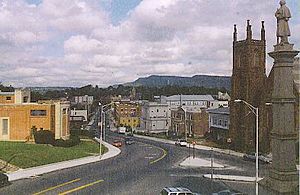
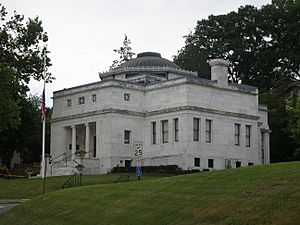
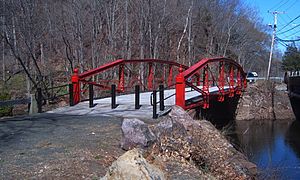
- Civil War Monument: This monument stands in front of Meriden City Hall. It lists the names of 158 men from Meriden who died in the Civil War.
- Curtis Memorial Library Building: Built in 1903, this beautiful building is an example of Neo-Classical architecture. It is now the Augusta Curtis Cultural Center.
- Giuffrida Park: This park offers many chances for outdoor fun. You can find hiking trails and a lake here.
- Historical Cemeteries: Visit the Meetinghouse Hill Burying Ground (used from 1727–1771) and the Broad Street Cemetery (first used in 1771). The Broad Street Cemetery has a plaque honoring the Revolutionary War.
- Hubbard Park: This large park covers about 1,800 acres and is part of the Hanging Hills. It includes Castle Craig, a famous landmark.
- Meriden Main Post Office: This historic building was designed in 1907.
- Miller Company Addition: See the black-and-white modern building on Center Street. It was designed by the famous architect Philip Johnson in 1965.
- Solomon Goffe House: This house was built in 1711 and is one of the oldest buildings in Meriden.
- Ted's Restaurant: This restaurant is famous for its steamed cheeseburger, a special kind of cheeseburger invented in the early 1900s.
- Hiking Trails: Parts of the Mattabesett Trail and the Metacomet Trail go through Meriden. You can also explore the Quinnipiac River Gorge Trail and the Hanover Pond Trail.
- Meriden Mall: A popular shopping center in the city.
- Gallery 53: This is home to the Arts & Crafts Association of Meriden.
Education in Meriden
The Meriden Board of Education runs several public schools:
Elementary Schools (Grades K–5)
- John Barry
- Benjamin Franklin
- Nathan Hale
- Hanover
- Thomas Hooker
- Casimir Pulaski
- Israel Putnam
- Roger Sherman
Middle Schools (Grades 6–8)
- Lincoln
- Washington
- Edison
High Schools
- Francis T. Maloney High School
- Orville H. Platt High School
- H. C. Wilcox (a technical high school)
Other schools nearby include Catholic high schools like Xavier High School (for boys) and Mercy High School (for girls) in Middletown. Private schools like Cheshire Academy and Choate Rosemary Hall are in nearby towns.
News and Media
The Meriden Record Journal is the local newspaper. It covers news for Meriden and nearby towns like Wallingford and Cheshire.
Transportation in Meriden
Highways
Meriden is located on Interstate 91, which connects to cities like Hartford and New Haven. Interstate 691 connects to Interstate 84 and goes west towards Waterbury. The Wilbur Cross Parkway (Route 15) also passes through Meriden.
Trains
The Meriden Transit Center is in downtown Meriden. It's on the New Haven–Springfield Line, which runs between New Haven and Springfield. You can catch CT Rail's Hartford Line commuter trains here, as well as Amtrak trains like the Northeast Regional and Vermonter.
Buses
Meriden is part of the Connecticut Transit System, which is a big public bus network. Three bus lines travel through Meriden, connecting to different parts of the city and to other towns like New Haven and Hartford.
Airports
Meriden Markham Municipal Airport is a city-owned airport for private and charter planes. For bigger commercial flights, the closest airports are Bradley International Airport (BDL) in Windsor Locks and Tweed New Haven Airport (HVN) in East Haven.
Famous People from Meriden
Since 1975, the Meriden Hall of Fame has honored notable people from the city. Their plaques are displayed in Meriden City Hall.
Arts and Creative Fields
- Beau Billingslea (born 1944), actor
- Gary Burr (born 1952), musician and songwriter
- Miguel Cardona (born 1975), former United States Secretary of Education
- Tomie dePaola (1934–2020), author and illustrator of many children's books
- Jennifer DiNoia (born 1982), singer and stage actress
- Rob Hyman (born 1950), rock musician and a founder of The Hooters
- Rosa Ponselle (1897–1981), a famous opera singer
Science and Technology
- Vincent Lamberti (1927–2014), a researcher who helped create Dove soap.
Military Heroes
- Kevin Lacz (born 1981), a former Navy SEAL and actor.
- Muriel Phillips (1921–2022), a US Army nurse during World War II.
- Joseph Pierce (1842–1916), a soldier born in China who fought in the Civil War.
Business Leaders
- William Yale, a successful merchant in the early 1800s.
Sports Stars
- John Jenkins (born 1989), a defensive tackle in the National Football League.
- Kid Kaplan (1901–1970), a world champion boxer.
- Gary Waslewski (born 1941), a Major League Baseball player.
Images for kids
See also
 In Spanish: Meriden (Connecticut) para niños
In Spanish: Meriden (Connecticut) para niños



